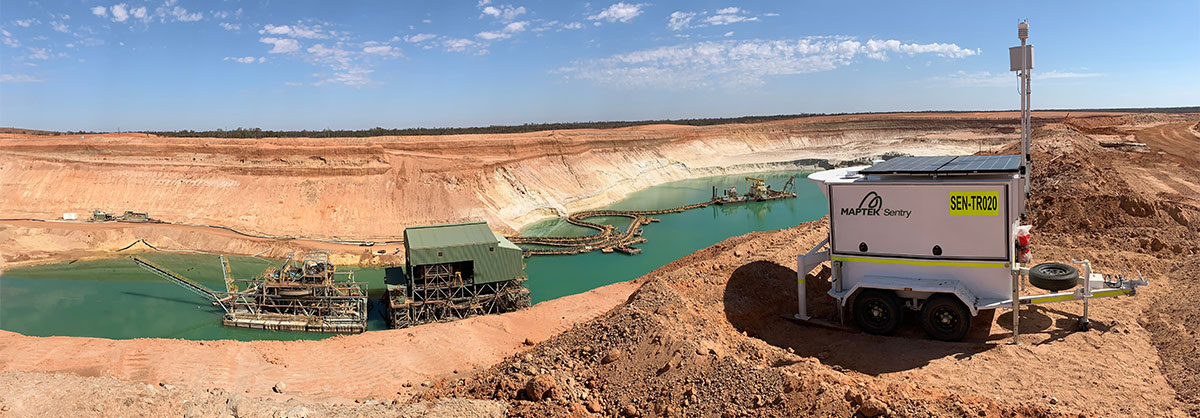December 2019 Issue Index
Stability monitoring for peace of mind
Continuous monitoring using Maptek Sentry provided effective risk management during equipment maintenance at an Australian mineral sand operation.
Tronox has purchased Maptek Sentry after a rental trial to monitor a floating concentrator while a dredge pond was drained for maintenance work.
The Ginkgo and Snapper mines are located about 85 kilometres north of Mildura in southwest New South Wales. The mineral sand deposits are relict beaches from an inland sea that existed 7 million years ago.
Both mines use conventional tractor scoops for topsoil handling, truck and shovel operation for overburden, and wet dredge mining and floating concentrator plants to recover and separate the heavy minerals in the ore deposit.
The heavy mineral concentrate obtained by the wet-dredging process is pumped ashore to the mineral concentrate stockpiles and separated into three streams containing primarily ilmenite, ilmenite and leucoxene, and rutile and zircon.
Ginkgo operators wanted to be sure the concentrator was not shifting on the soft bed when the dredge pond was drained for maintenance work, so they would be able to alert staff to clear the area if any movement occurred.
In February 2019 Sentry was set up on the bank of the pond to monitor the concentrator while the maintenance was undertaken.
Sentry captures laser scan data continuously to compare new scans to earlier scans and detect any movement.
Intuitive Sentry software displays movement as both graphs and heatmaps, making data easy to understand and analyse. Alarms can be set if movement thresholds are breached.
Multiple zones of interest can be monitored simultaneously, meaning that pontoons, side walls and roofs of the plant on the dredger could all be analysed.
Sentry can focus on areas as small as a couple of square metres. Separate notification thresholds can be set for each area, allowing users to filter out the necessary movement of the maintenance workers and equipment.
The site used Sentry with a Maptek LR3 laser scanner to detect potential movement down to as little as a few millimetres.
Tronox Superintendent Surveying Pieter Bekker says that Sentry was a highly successful application and provided peace of mind to the operation during the docking, refurbishment and re-floating of the concentrator plant.
‘It proved invaluable as an early warning system to ensure the safety of all personnel accessing the area.’
When the concentrator was being refloated Sentry was able to determine its flotation point, showing the minimum water level to keep afloat.
Tronox will now apply Sentry to monitor the slopes of the Gingko pit and the dredge pond.

‘We are also looking at new applications for automated monitoring of the progress of overburden removal where capturing the survey data is time critical, for example rapid advance of overburden removal and backfill,’ says Bekker.
The mine uses a Maptek XR3 laser scanner and vehicle mount for day to day survey tasks on site. The LR3 will be able to assist with this work when it is not being used for Sentry.
Bekker says 24/7 remote access to Sentry from multiple devices combined with its alarm system was important to the operation.
‘Continuous monitoring was key to us and this is very hard to achieve with conventional survey methods,’ he says.
‘We now have a second scanner to use for general surveying and the added benefit of stability monitoring capability.’
Thanks to
Pieter Bekker
Superintendent Surveying
Tronox
- Continuous monitoring using Sentry provided effective risk management for Tronox during equipment maintenance at a mineral sand operation.
- Movement displayed as graphs and heatmaps makes the monitoring information easy to understand and analyse.
- 24/7 remote access to Sentry from multiple devices combined with its alarm system was important for ensuring the safety of all personnel accessing the area.

